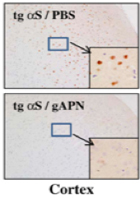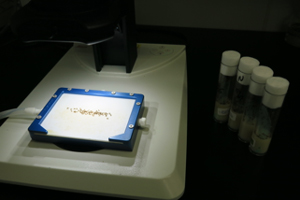
- HOME
- Laboratory of Parkinson's Disease
Laboratory of Parkinson's Disease

Laboratory Head
Makoto Hashimoto
Backgrounds
Protection of neurodegenerative diseases
Research description
The number of patients with age-associated neurodegenerative diseases, such as Alzheimer’s disease (AD) and Parkinson’s disease (PD), is rapidly increasing worldwide. Consequently, huge costs for medical treatment and nursing care for these patients have become a serious socioeconomic dilemma. Nonetheless, extensive studies of amyloid immunotherapy in AD have been so far unsatisfactory. Thus, the development of an effective disease-modifying therapy is the highest priority in neurodegenerative disease research.

Fig1. Effect of adiponectin on
neurodegeneration in tg mices

Fig.2 Drosophila molecular genetics
In our laboratory, we seek to exploit a mechanism-based disease-modifying strategy for α-synucleinopathies, such as PD and dementia with Lewy bodies. In this context, we have a particular interest in the suppressive effect of adiponectin on neurodegeneration (Fig.1). We will also attempt to identify new molecules that could be useful for the prevention of neurodegenerative diseases. For such purposes, we currently perform the Drosophila molecular genetics (Fig.2) in addition to cell biological and transgenic mice studies. Apparently, the results will be applicable to other diseases, including AD and Huntington’s disease.
Members
Laboratory Head Makoto Hashimoto
- Yoshiki Takamatsu
Selected Publications
- Hashimoto M, Ho G, Takamatsu Y, Wada R, Sugama S, Takenouchi T, Waragai M, Masliah E. (2019) “Possible Role of Amyloid Cross-Seeding in Evolvability and Neurodegenerative Disease.”J Parkinsons Dis. in press.
- Takamatsu Y, Ho G, Waragai M, Wada R, Sugama S, Takenouchi T, Masliah E, Hashimoto M. (2019) “Transgenerational Interaction of Alzheimer's Disease with Schizophrenia through Amyloid Evolvability.” J. Alzheimers Dis. 68(2):473-481.
- Hashimoto M, Ho G, Takamatsu Y, Shimizu Y, Sugama S, Takenouchi T, Waragai M, and Masliah E. (2018) “Evolvability and Neurodegenerative Disease: Antagonistic Pleiotropy Phenomena Derived from Amyloid Aggregates.” J. Parkinsons Dis. 8(3):405-408.
- Hashimoto M, Ho G, Sugama S, Takamatsu Y, Shimizu Y, Takenouchi T, Waragai M, and Masliah E. (2018) “Evolvability of Amyloidogenic Proteins in Human Brain.” J. Alzheimers Dis. 62:73-83.
- Waragai M, Ho G, Takamatsu Y, Sekiyama K, Sugama S, Takenouchi T, Masliah E, and Hashimoto M. (2017) “Importance of adiponectin activity in the Pathogenesis of Alzheimer's Disease.” Ann. Clin. Transl. Neurol. 4:591-600.
- Takamatsu Y, Ho G, Koike W, Sugama S, Takenouchi T, Waragai M, Wei J, Sekiyama K, and Hashimoto M. (2017) “Combined immunotherapy with “anti-insulin resistance” therapy as a novel therapeutic strategy against neurodegenerative diseases.” NPJ Parkinson’s Disease 3: 4.
- Takamatsu Y, Koike W, Takenouchi T, Sugama S, Wei J, Waragai M, Sekiyama K, and Hashimoto M. (2016) “Protection against neurodegenerative disease on Earth and in space.” NPJ Microgravity 2: 16013.
- Waragai M, Adame A, Trinh I, Sekiyama K, Takamatsu Y, Une K, Masliah E, and Hashimoto M. (2016) “Possible Involvement of Adiponectin, the Anti-Diabetes Molecule, in the Pathogenesis of Alzheimer's Disease.” J. Alzheimers Dis. 52:1453-1459.
- Sekiyama K, Takamatsu Y, Koike W, Waragai M, Takenouchi T, Sugama S, and Hashimoto M. (2016) “Insight into the Dissociation of Behavior from Histology in Synucleinopathies and in Related Neurodegenerative Diseases.” J. Alzheimers Dis. 52:831-841.